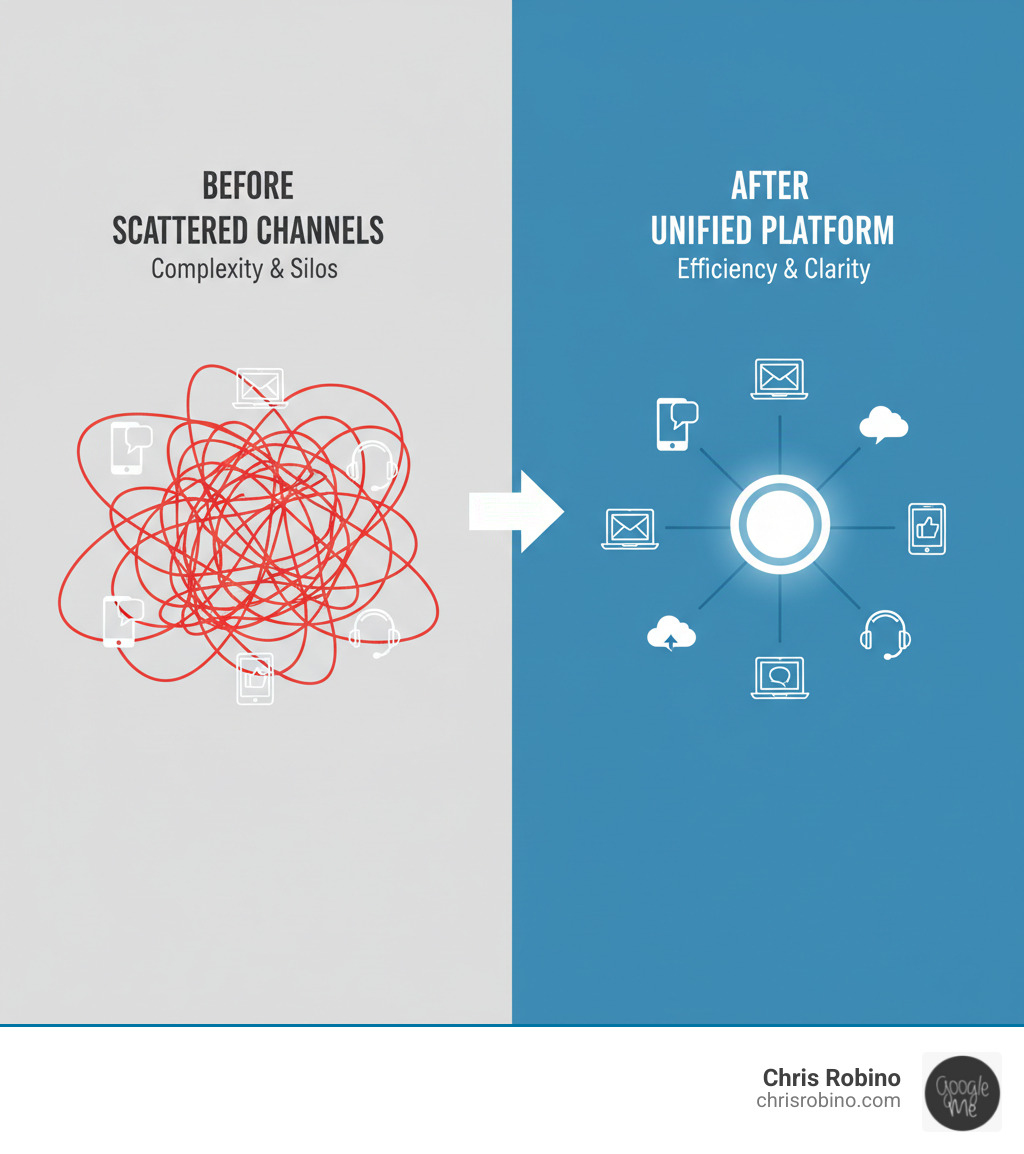Why Large Enterprises Need a Unified SEO Strategy
Enterprise SEO is the discipline of driving sustainable, compounding organic growth across complex, large-scale web ecosystems—multiple domains and subdomains, vast product catalogs, dynamic frameworks, and global audiences. It’s not a checklist; it’s an operating model that aligns product, engineering, content, design, data, and legal to win visibility and share of intent at scale.
Quick overview:
- What it is: A cross-functional, technology-enabled growth practice that integrates technical excellence, content operations, and governance to capture and protect demand in search.
- Key benefits: Lower marginal customer acquisition costs, durable traffic independent of ad auctions, stronger brand authority, and faster releases with SEO built into workflows.
- Best for: Organizations with many templates, regions, brands, or product lines where small inefficiencies compound and small wins scale.
- Core pillars: Technical SEO at scale, information architecture, content and schema at scale, internal linking, international SEO, performance and accessibility, governance, and measurement.
Large companies often inherit SEO complexity: fragmented site structures, overlapping taxonomies, thousands of orphaned pages, and inconsistent metadata across templates. Add JavaScript-heavy experiences, frequent deployments, and global variants, and you get crawl waste, index bloat, thin content, and quality regressions that erode visibility.
A unified enterprise SEO strategy creates one source of truth for how your organization structures URLs, ships components, measures impact, and manages risk. It embeds SEO into the software delivery lifecycle, standardizes patterns (canonicalization, pagination, hreflang, schema), and uses automation for monitoring and QA. The result is a system that scales breakthroughs across millions of URLs while preventing regressions.
The payoff is material: more qualified traffic that compounds, stronger protection during market volatility, and a customer experience that’s discoverable, fast, and helpful—everywhere your brand shows up.

The Foundation: Enterprise SEO That Scales
Think of enterprise SEO as the control tower for organic growth. It coordinates how pages get built, linked, rendered, and measured—so search engines can consistently find, understand, and rank your content.
The Problems That Appear at Scale

- Crawl budget waste from faceted navigation, parameters, and duplicative paths.
- JavaScript rendering challenges (hydration delays, blocked resources) that hide content and links.
- Template inconsistency: title/meta patterns drift, heading hierarchies break, and schema is missing or malformed.
- Weak internal linking and orphaned pages that dilute equity and bury valuable content.
- Index bloat from near-duplicates, out-of-stock variants, and thin placeholder pages.
- Core Web Vitals variability across templates causing quality downgrades and revenue loss.
- Risky migrations and replatforms without redirect planning, parity checks, or rollback paths.
- International SEO misfires (hreflang conflicts, language/country mismatch, duplicate English variants).
- Governance gaps—no release gates, no SEO QA in CI/CD, and no alerting—leading to regressions.
- Consent and privacy changes that break analytics visibility and obscure true impact.
Strategic Advantages of a Single Source of Truth for SEO
A centralized SEO operating model creates cohesion and speed:
- Standardized architecture: URL, canonical, pagination, robots, and hreflang policies applied across all templates.
- Component library with SEO built in: metadata modules, structured data, link blocks, and breadcrumb systems that ship once and scale everywhere.
- Unified taxonomy and naming conventions to reduce duplication and strengthen topical authority.
- Automated monitoring: log-file analysis, crawl diffs, schema validation, and performance budgets with alerting.
- Data foundation: consistent tracking across analytics and search data, plus dashboards for leaders and practitioners.
- Cross-functional rituals: intake, prioritization, sprint integration, and release gates that prevent regressions.
- Clear ownership: RACI for technical, content, and international workflows, with SLAs and escalation paths.
With these foundations, SEO becomes predictable, resilient, and compounding—capable of supporting major product priorities while protecting the moat you’ve already built. Leading search engine guidelines emphasize that establishing clear technical foundations and governance is essential for maintaining search visibility at scale.
Implementing Enterprise SEO Across the Organization
Shifting from ad hoc SEO tasks to an enterprise program requires an operating model that ties strategy to execution, with the right technical underpinnings, content engine, and governance.
Essential Components of High-Performing Enterprise SEO
-
Technical SEO at scale
- Crawl control: robots directives by environment, clean parameter handling, XML sitemaps segmented by type and freshness.
- Canonical and pagination: consistent canonicals, proper rel=prev/next alternatives via internal linking and sitemaps.
- Rendering: server-side rendering, pre-rendering, or hybrid strategies so primary content and links are available on first load.
- Structured data: organization, product, article, FAQ, how-to, and breadcrumb schema validated and rolled out via components.
- Faceted navigation: allowlist approach with nofollow/noindex where needed; self-referencing canonicals on constrained filters.
- Performance and Core Web Vitals: image optimization, critical CSS, script de-duplication, resource hints, and performance budgets enforced in CI.
- Accessibility: semantic HTML and ARIA patterns that also improve comprehension for search engines.
- Security and platform: edge caching, CDN rules, reliable redirects, and header configurations managed as code.
-
Information architecture and internal linking
- Intent-aligned taxonomies that reflect how customers search, not just how teams organize.
- Templates for hubs, sub-hubs, and leaf pages with clear heading hierarchy and contextual related links.
- Breadcrumbs and navigational links to reduce depth and strengthen topical clusters.
- Link budget strategy that elevates highest-value pages and prevents equity leaks.
-
Programmatic and template-driven content
- Scalable templates that produce unique, helpful pages backed by high-quality data.
- Content guardrails: deduplication logic, canonical management, and quality thresholds to avoid thin pages.
- Continuous improvement loops: CTR testing on titles/descriptions, on-page experiments, and regular content refreshes.
-
Content operations and quality
- Editorial calendars driven by demand and lifecycle (launches, seasonality, refresh cadence).
- Briefs that specify intent, entity coverage, structured data, and internal links.
- Expert review processes and clear bylines to strengthen experience and trust.
- Media optimization (images/video) with descriptive alt text, transcripts, and compressed delivery.
-
Entity-led strategy and schema
- Clarify your entity graph: people, products, places, and concepts related to your brand.
- Use schema to reinforce entity connections and improve eligibility for rich results.
- Consolidate scattered content to build clear topical authority.
-
International SEO
- Market prioritization by TAM, competition, and operational readiness.
- Hreflang governance with language-country pairs, x-default, and parity checks.
- Localization over translation: cultural nuance, pricing, availability, and local proof.
- Store-locator architecture and local pages for physical footprint.
-
Measurement and experimentation
- KPIs that match business goals: non-brand growth, share of intent, revenue influence, and marginal CAC.
- Leading indicators: crawlability, indexation, Core Web Vitals, CTR curves, and SERP feature presence.
- Controlled testing for titles, internal links, and template elements; change logs tied to outcomes.
-
Automation and monitoring
- Scheduled crawls and log-file analysis to detect indexation anomalies.
- Schema and meta validators, broken-link scans, and redirect chain checks.
- Alerts for robots changes, 5xx spikes, rendering failures, and CWV regressions.
- CI/CD gates that block releases when critical SEO checks fail.
Choosing the Right Operating Model and Stack
- Integration with product and engineering: put SEO into discovery, acceptance criteria, and sprint rituals so it’s shipped with features—not after.
- Data integration: unify analytics, search data, and logs in a warehouse for consistent dashboards and forecasting.
- Governance and compliance: consent management, privacy-safe measurement, and secure tag management.
- Documentation and training: playbooks for URLs, schema, hreflang, redirects, and content briefs; onboarding for new teams.
- Resourcing and SLAs: a defined intake process, response times, and escalation paths for incidents (e.g., deindexation risk).
- Center of excellence: a small core team that sets standards and enables business units to execute within guardrails.
How Enterprise SEO Lifts Acquisition and Efficiency
Enterprise SEO compounds. Each template improvement, each link module, each schema enhancement improves thousands of pages at once. High-intent traffic lowers marginal CAC, stabilizes acquisition when paid channels fluctuate, and expands your brand’s share of results across markets. Internally, SEO standards reduce rework, speed up releases, and minimize costly regressions—freeing teams to focus on innovation rather than cleanup.
The outcome is a durable, defensible growth engine that scales with your portfolio and protects the equity you’ve earned.
The Future of Enterprise SEO
Enterprise SEO continues to evolve alongside search experiences, privacy expectations, and user behavior. The next wave will reward organizations that combine technical rigor with trustworthy, helpful content—and that operationalize SEO inside their build and governance systems.
The Role of AI, Privacy, and SERP Changes
-
Generative search and zero-click experiences
- Optimize for answers and entity clarity so your content surfaces in enriched results.
- Build content that earns citations: original data, expert analysis, and clear structure (tables, steps, FAQs).
-
AI-assisted production and QA—with guardrails
- Use AI for research, outlines, and variant testing, while keeping human expertise, fact-checking, and brand voice.
- Automate quality checks: duplication detection, schema validation, and reading-level alignment.
-
Predictive and prescriptive analytics
- Forecast demand shifts, identify crawl/index bottlenecks early, and prioritize actions by expected impact.
- Combine log data, search data, and business metrics to calibrate ROI and defend roadmaps.
-
Edge SEO and platform engineering
- Execute redirects, header rules, and geo logic at the edge for speed and reliability.
- Test SEO changes safely with feature flags and gradual rollouts.
-
First-party data and privacy
- Strengthen measurement with consented first-party data and modeled insights that respect user choices.
- Align SEO with broader data minimization and security standards to safeguard trust.
-
Multimodal and multilingual search
- Invest in high-quality video, imagery, and structured assets that explain and demonstrate, not just describe.
- Mature localization practices to win intent across languages and markets.
-
Sustainability and performance
- Performance budgets and efficient delivery reduce emissions, costs, and bounce risk—benefiting users and rankings.
As you navigate what’s next, keep your focus on durable fundamentals: fast, accessible pages; clear information architecture; credible, expert content; and automation-backed governance. Establish an enterprise roadmap that secures quick wins (crawl cleanup, CWV improvements, schema rollout) while building long-term advantages (entity authority, international expansion, and template excellence). That balance lets large organizations move fast without breaking the compounding engine SEO can be.


